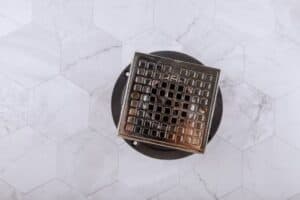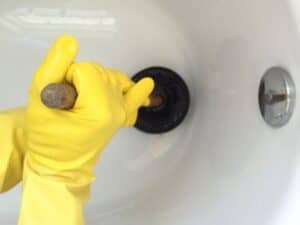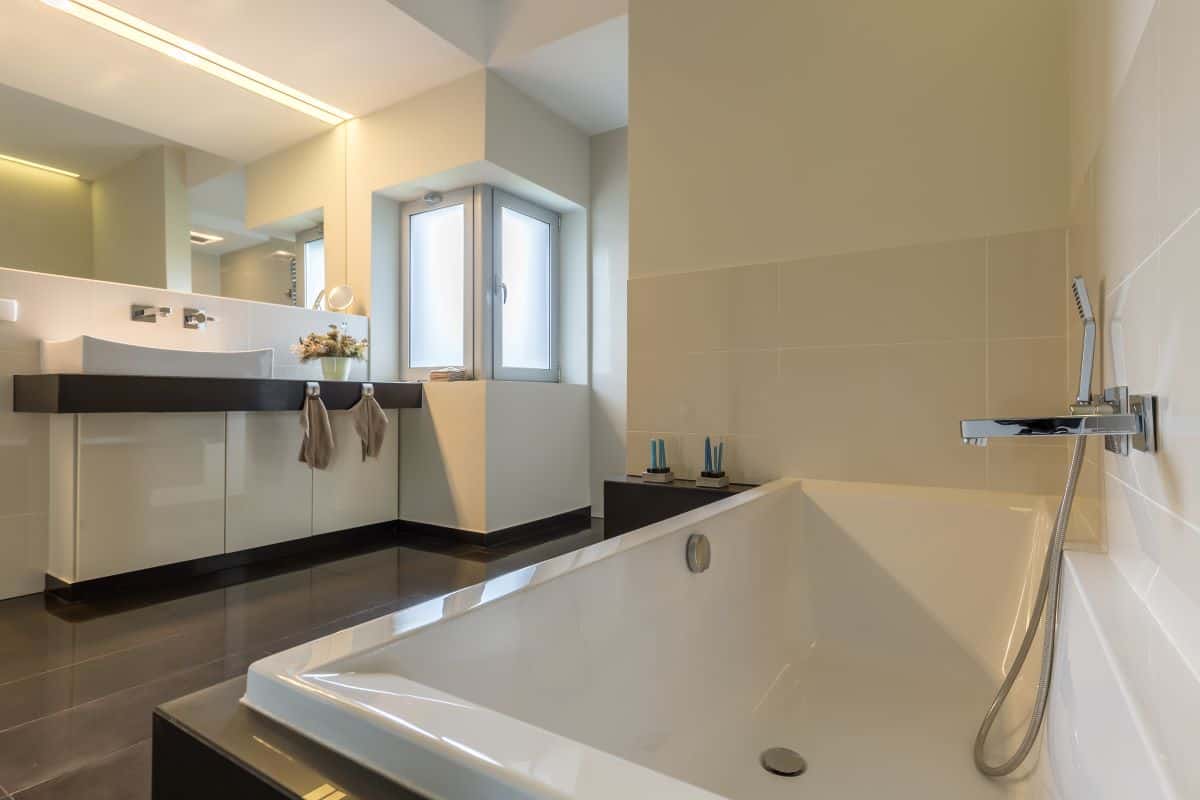Clear Your Clogged Bathtub Drain With These Easy Tips
We’ve all been through it before. Clogged bathtub drains are an issue almost every homeowner will encounter. Here are some of the best DIYs you can try to clear your clogged bathtub drain. Make it easier for water to pass through the pipes without having to call on a professional plumber.
What is the best DIY to clear your clogged bathtub drain? The best trick is to pour some baking soda down the drain. Try to just pour about half a cup of baking soda into the clogged drain. Then follow it up with a cup of white vinegar. This will allow the two ingredients to mix and create a bubbly reaction which will help clear out the clog.
Although this method is a great option. There are other alternatives. They can help clear out a clogged bathtub drain. Depending on what you have readily available at your house, some DIY cleaning solutions may be quite useful.

Best DIYs For Clogged Bathtub Drains
Clogged bathtub drains are not fun to deal with. But, there are some ways to clear out clogged bathtub drains without calling on a professional plumber. Here are the best DIY’s for clogged bathtub drains:
Baking Soda and White Vinegar
The best DIY is baking soda and white vinegar. Pour half a cup of baking soda into the clogged bathtub drain and then follow that up with a cup of white vinegar.
Allow the ingredients to mix and create a reaction to clear out the clog.
Salt and Boiling Water
One great DIY for clogged bathtub drains is to pour salt down the drain followed by boiling water once it starts coming back up again. This should help clear out any particles or items that may be in your pipes.
Plumbing Snake
If professional plumbers are not an option, using a plumbing snake can also help unclog bathtub drains. A plumbing snake is basically just like an auger, which can push through materials inside your pipe to clear out a clogged bathtub drain.
Draino
If all else fails, Draino is always an option. This has always been a great option to clear your clogged bathtub drain.
Simply follow the directions on the bottle and allow it to sit for a few minutes to clear out the clog in your drain.
With these effective techniques, you should no longer have to worry about being frustrated over clogged bathtub drains. Make sure to always do your research when testing out new combinations to get your drain unclogged.
What Is the Best Tool to Use When Clearing a Bathtub Drain?
A clogged bathtub drain can be very frustrating. The clog can be caused by excess hair or soap scum, or it may have been clogged up by a toy or some other object that accidentally fell into the tub.
There are many tools available to help clear out clogs in a bathtub drain, including the common plunger and drain snake. The best tool to use when clogging a bathtub drain is the plunger.
Alternatives to these tools can be used to unclog bathtub drains, and may even help you avoid the need to call a plumber. For example:
- Hair can be removed by putting on rubber gloves and pulling the hair out since it is easiest to remove in larger clumps.
- Pulling out soap scum and hair with a bent metal hanger will make the drain clear again.
- Toys and other objects that have fallen into bathtubs can be retrieved by using a coat hanger and inserting it into the bathtub drain.
How to Use a Plunger to Unclog a Bathtub Drain
First, wet the rubber suction cup and place it over the clogged drain; then proceed to pump it up and down to create suction.
Sometimes you will need to plunge multiple times before the clog is clear, but eventually, your clogged tub should be draining properly.
If the clog has not been removed by plunging, you can use a drain snake.
How to Use a Drain Snake to Unclog a Bathtub Drain
While the bathtub is still wet from using the plunger, attach one end of the drainpipe to the end of the drain snake that has an opening for the clog to enter.
Then, feed the snake down the clogged drain until you feel it hit the clog; then immediately reverse directions and pull back up slowly. Repeat this process until your clog has been removed completely.

Why Is My Bathtub Drain Always Clogged?
Although the most common reason for a clogged bathtub drain is the excess hair that comes from everyday washing, many are unaware that a clogged bathtub drain can be caused by a variety of other things. There are several reasons for this and cures to try before you call in the professionals.
The bathtub drain is a fairly simple component of the bathtub. It’s designed with a stopper so water can come in and fill the bathtub as well as a hose for draining the bathtub water.
The bathtub drain is usually located at one of four positions: in the middle of the bathtub near the faucet, on the right side, on the left side, or towards to back corner of the bathtub. Most bathtubs don’t have bathtub drains that are visible and most bathtub drains are covered by bathtub stoppers.
Both plastic and metal bathtub drains can be removed easily with only basic tools like screwdrivers, pliers, and wrenches so bathtub drain cleaning is something most homeowners can do on their own.
Preventing a Clogged Drain
One of the best things you can do to prevent bathtub drain clogs is to remove hair before it has a chance to go down the drain. It’s easy for your bathtub drain to be clogged when it’s filled with tangled-up hair that builds up and won’t go down the bathtub drain.
This can be as simple as removing the hair from the drain after every shower. You can also use one of the bathtub drain covers that has a rubber riser built-in, or you can purchase an inexpensive bathtub drain strainer with small holes to keep your bathtub drains unclogged.
How To Remove Stains From a Bathtub
To clean stains from your bathtub, you can use products available at grocery stores or specialized cleaning products available at most supermarkets.
Most of these are very effective, but the best way to remove stains from your bathtub is to prevent them in the first place by avoiding certain actions while bathing. For instance, don’t let hair color rinse into your bathtub as it can be difficult to remove and may stain.
Home cleaning products remove many types of stains, such as rust and hard water deposits. The best products are usually chlorine-based products. They remove stains by chemically altering their composition and making them easy to remove with a sponge or brush.
Many modern baths are made from acrylics or other materials that can be easily cleaned with a soft cloth and warm water, but older bathtubs may require the help of specialized cleaning tools available at hardware stores to remove stains.
You can clean mildew and soap scum by using special solutions available at grocery stores and pharmacies. These will remove all mold and prevent them from coming back for up to three months.
What Causes Yellow Stains In a Bathtub?
Stains in bathtubs are embarrassing and can be difficult to remove. Unfortunately, it is very common for bathtub stains to appear yellow because the bathtub’s plumbing does not drain completely after each bath.
The yellow color comes from a bathtub’s metal plating, which consists of zinc, chrome, or nickel. Water that is not fully drained will evaporate, but some minerals are left behind in the bathtub.
When water evaporates, these minerals are exposed to bathwater more quickly and release an orange-yellow color called “bather’s ring.” This yellow bath ring is a bathtub’s way of telling you that it needs to be cleaned.
You can use an acidic solution as a bathtub cleaning product to prevent yellow bathtub rings from developing.
How to Clean Yellow Stains In Your Bathtub
Mix white vinegar with water in equal ratios and pour this mixture into the bathtub when bathwater drains, after every bath. This will keep bathwater from sticking to the bathtub, causing it to develop yellow bath rings. Rinse the bathtub with water after each cleaning.
If you do not want to keep adding vinegar and water, an alternative is to clean your bathtub with baking soda. Mix approximately 1 cup of baking soda in a bucket or sink filled with the warm bath water and let the bathtub soak for 30 minutes. Remove the bath ring with a sponge and repeat as necessary.
Harsh chemicals like bleach should not be used to clean bathtubs because they can damage the bathtub’s finish and turn it yellow.

Conclusion
Bathtubs are where we spend much of our time at bath time, but sometimes bathtubs can be harbors of filth and germs. Luckily keeping bathtubs clean is not a difficult task. Regular cleaning with the correct products will keep bathtubs looking pretty and clean for a long time.
Remember, you cannot have a clean bathtub without cleaning out your drain regularly, otherwise cleaning bathtubs is a useless task!

